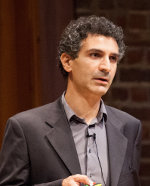IEEE IoT Newsletter - September 2016
Privacy in the Internet of Things: Regulation vs Innovation
Cigdem Sengul
Every investor, innovator, and potential consumer of an IoT-based application asks the same set of questions: Is it useful? Does it work? Can I trust it? Among the three, the trust question is critical, as IoT extends to everyday items not normally considered computers, allowing them to generate, exchange and consume data with minimal human intervention [1].
Past Mistakes, Present Opportunities: Location-based Service Lessons for Consumer IoT
Prasant Misra
The pioneering vision of the Internet of Things (IoT), dating almost seventeen years into the past, is that of a ubiquitous society wherein people and "Things" are connected in an immersive networked computing environment, with the connected "Things" providing value to people or enterprises and their digital shadows, through intelligent social and commercial services.
The IoT4SDG Challenge
Stuart Sharrock
At the end of 2014 the United Nations released the results of the largest survey ever undertaken in its 70-year history, reaching over seven million people in 88 countries all over the world. The My World survey was one input to three years of negotiations and debate climaxing in September 2015 when 193 countries agreed to a set of 17 development goals and 169 targets to be achieved by 2030. In 2016 the international community is embarking on the implementation of these goals and targets. What’s this all about?
Social Engineering Attacks on the Internet of Things
Ian G. Harris
Internet of Things (IoT) devices are accepted and trusted parts of everyday life for many people today. IoT devices and networks are known to be more vulnerable to traditional cyber-attacks than traditional desktop/server platforms for many reasons including their limited computational power, use of ad hoc networking protocols, and limited battery lifetimes. A security risk associated with IoT which is often overlooked is the increased vulnerability to social engineering attacks which are psychological attacks directly on humans using devices, rather than the devices themselves.
This Month's Contributors
Cigdem Sengul is a senior researcher at Nominet and works on privacy in the Internet of Things.
Read More >>
Prasant Misra is a scientist at TCS Research and Innovation, TATA Consultancy Services, Bangalore.
Read More >>
Stuart Sharrock has been working as an analyst and consultant in the telecommunications industry for the past three decades.
Read More >>
Ian G. Harris is an Associate Professor and currently Vice Chair of Undergraduate Education in the Computer Science Department at the University of California Irvine.
Read More >>
Contributions Welcomed
Click Here for Author's Guidelines >>
Would you like more information? Have any questions? Please contact:
Raffaele Giaffreda, Editor-in-Chief
raffaele.giaffreda@create-net.org
Stuart Sharrock, Managing Editor
stuartsharrock@ieee.org
About the IoT eNewsletter
The IEEE Internet of Things (IoT) eNewsletter is a bi-monthly online publication that features practical and timely technical information and forward-looking commentary on IoT developments and deployments around the world. Designed to bring clarity to global IoT-related activities and developments and foster greater understanding and collaboration between diverse stakeholders, the IEEE IoT eNewsletter provides a broad view by bringing together diverse experts, thought leaders, and decision-makers to exchange information and discuss IoT-related issues.
IEEE IoT Newsletter Editorial Board
Sign Up for IoT Technical Community Updates
Calendar of Events
IEEE 8th World Forum on Internet of Things (WF-IoT) 2022
26 October-11 November 2022
Call for Papers
IEEE Internet of Things Journal
Special issue on Towards Intelligence for Space-Air-Ground Integrated Internet of Things
Submission Deadline: 1 November 2022
Special issue on Smart Blockchain for IoT Trust, Security and Privacy
Submission Deadline: 15 November 2022
Past Issues
September 2022
July 2022
March 2022
January 2022
November 2021
September 2021
July 2021
May 2021
March 2021
January 2021
November 2020
July 2020
May 2020
March 2020
January 2020
November 2019
September 2019
July 2019
May 2019
March 2019
January 2019
November 2018
September 2018
July 2018
May 2018
March 2018
January 2018
November 2017
September 2017
July 2017
May 2017
March 2017
January 2017
November 2016
September 2016
July 2016
May 2016
March 2016
January 2016
November 2015
September 2015
July 2015
May 2015
March 2015
January 2015
November 2014
September 2014












